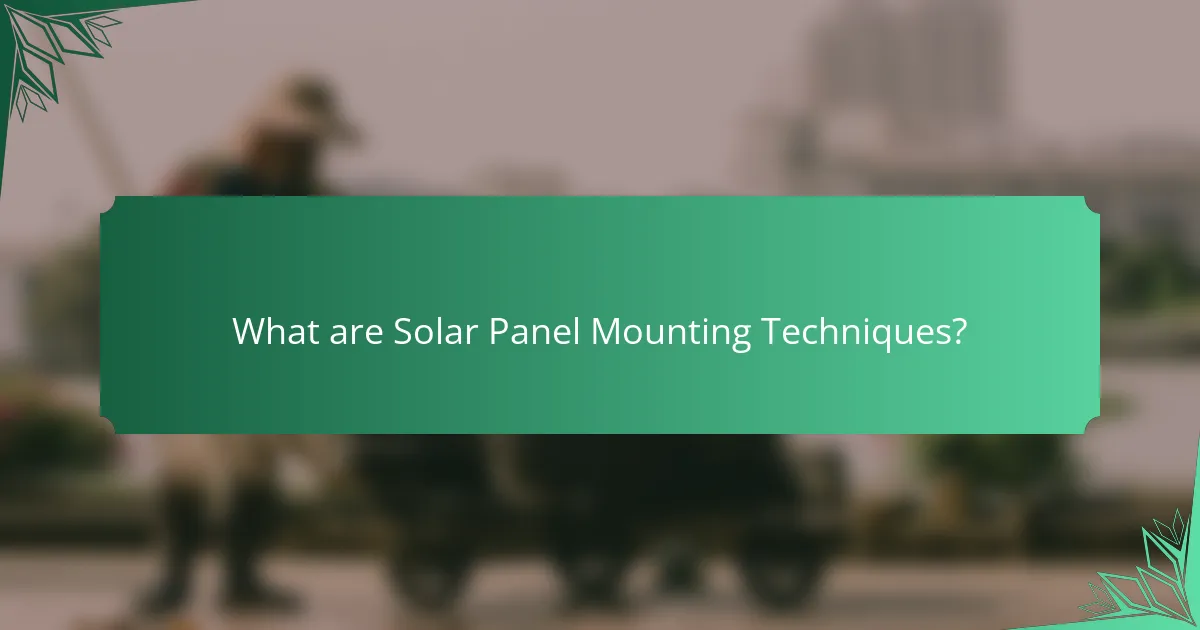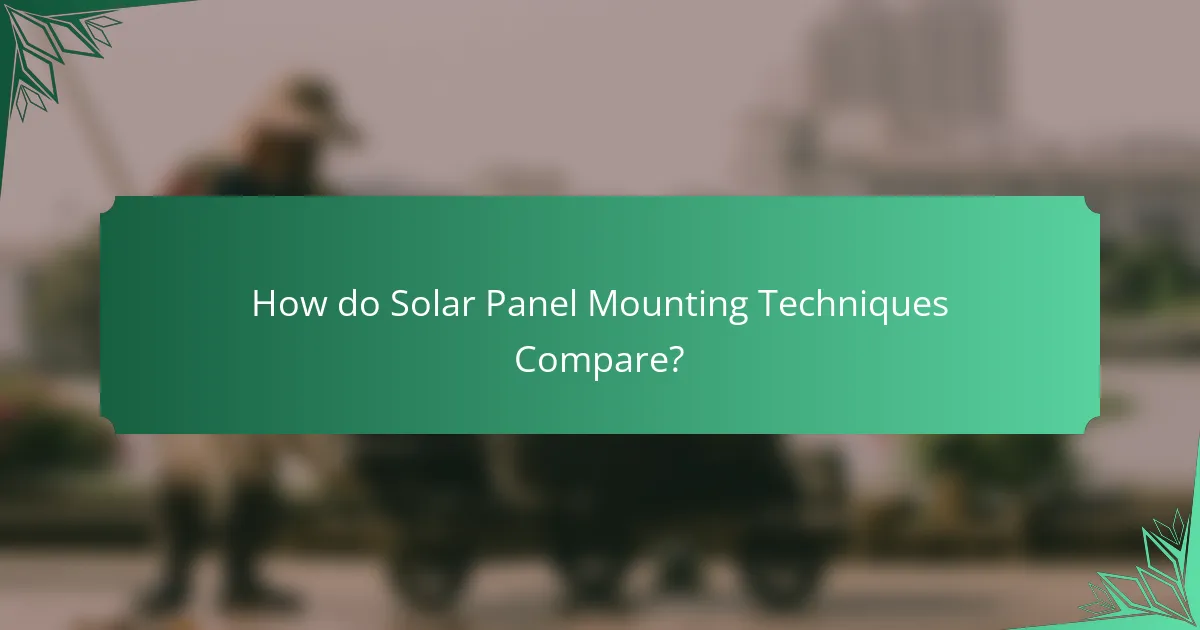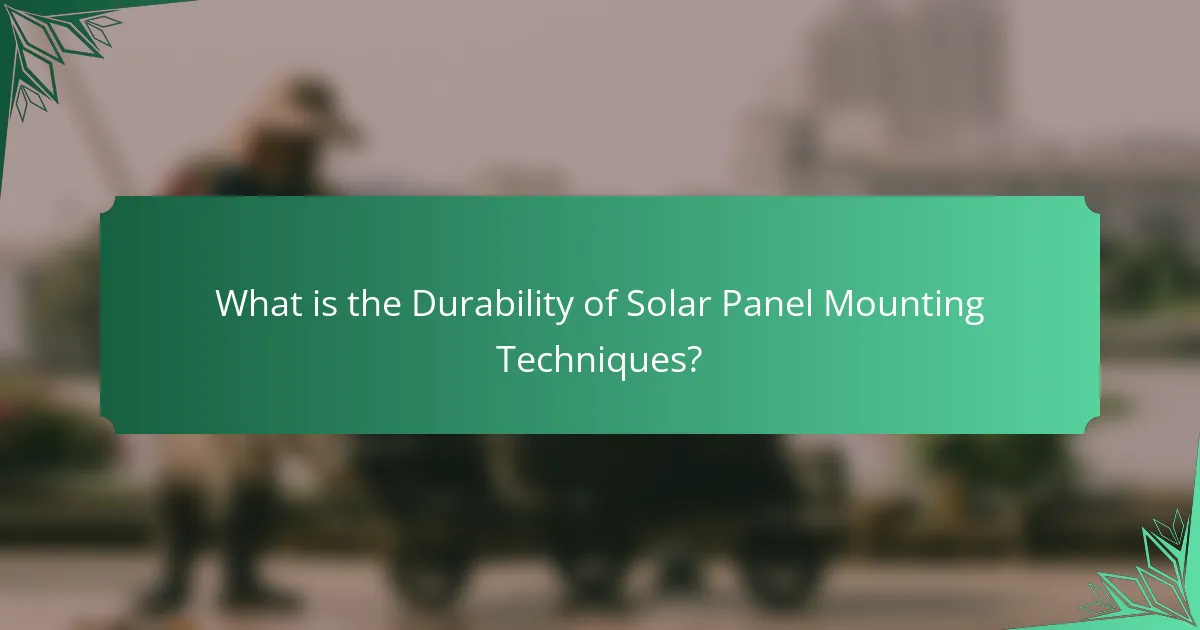
What are Solar Panel Mounting Techniques?
Solar panel mounting techniques refer to the methods used to secure solar panels to various surfaces. The primary techniques include fixed mounts, adjustable mounts, and tracking mounts. Fixed mounts hold panels in a stationary position, optimizing sunlight capture at a specific angle. Adjustable mounts allow for angle changes to maximize efficiency throughout the day. Tracking mounts follow the sun’s movement, increasing energy production by up to 25%. Each technique varies in installation complexity and cost. For instance, tracking mounts are generally more expensive due to their advanced mechanics. The choice of mounting technique impacts the overall durability and effectiveness of the solar panel system.
How do different mounting techniques affect solar panel performance?
Different mounting techniques significantly affect solar panel performance. Fixed mounts provide stability and are cost-effective, but they may not optimize sun exposure throughout the day. Adjustable mounts allow for changes in angle, improving energy capture during different seasons. Tracking mounts follow the sun’s path, increasing efficiency by up to 25% compared to fixed systems.
The material of the mounting system also plays a role. Aluminum mounts are lightweight and resistant to corrosion, enhancing durability. In contrast, steel mounts are heavier but offer greater strength in extreme weather conditions.
Research indicates that the orientation and tilt angle of solar panels can impact energy output by 10-20%. Proper installation and maintenance of mounting systems are crucial for maximizing performance and longevity.
What are the primary types of solar panel mounting systems?
The primary types of solar panel mounting systems are fixed, adjustable, and tracking systems. Fixed systems are stationary and hold solar panels at a specific angle. Adjustable systems allow for angle modifications to optimize sunlight exposure. Tracking systems move solar panels to follow the sun’s path throughout the day. Each type has distinct benefits and applications. Fixed systems are cost-effective and require less maintenance. Adjustable systems enhance energy capture but involve more complexity. Tracking systems can increase energy production by up to 25% compared to fixed systems.
How does the angle of installation influence energy capture?
The angle of installation significantly influences energy capture in solar panels. Optimal angles maximize sunlight exposure throughout the day. Solar panels installed at an angle close to the latitude of the location capture more solar energy. This is because they align better with the sun’s path across the sky. Research shows that adjusting the angle seasonally can increase energy capture by up to 20%. According to the National Renewable Energy Laboratory, a fixed tilt angle can lead to a 15% reduction in energy capture compared to optimal angles. Thus, proper installation angles are crucial for maximizing solar energy efficiency.
What factors should be considered when choosing a mounting technique?
When choosing a mounting technique for solar panels, consider factors such as terrain, panel type, and local regulations. Terrain affects stability and installation complexity. Different panel types may require specific mounting solutions. Local regulations can dictate mounting methods and compliance. Additionally, assess wind loads and snow loads in your area. Durability is crucial for long-term performance and resistance to environmental factors. Finally, installation costs and maintenance requirements should also be evaluated to ensure a suitable choice.
How does the type of roof impact the choice of mounting system?
The type of roof significantly impacts the choice of mounting system for solar panels. Different roof materials and structures require specific mounting solutions for optimal performance and durability. For example, flat roofs often utilize ballasted mounting systems, which rely on weight to secure the panels without penetrating the roof surface. In contrast, pitched roofs may use penetrative mounts that attach directly to the roof structure for stability.
Additionally, roofs made of asphalt shingles may require different flashing techniques compared to metal roofs, which can utilize clamps to secure the panels. The load-bearing capacity of the roof also influences the mounting choice; roofs with lower capacity may necessitate lighter, less invasive mounting systems. Furthermore, the orientation and angle of the roof impact the design of the mounting system to maximize solar exposure.
Overall, the compatibility of the mounting system with the roof type ensures the longevity and efficiency of the solar installation.
What are the environmental considerations for different mounting techniques?
Different mounting techniques for solar panels have unique environmental considerations. Fixed mounts generally have a lower environmental impact. They require minimal land disturbance and are often installed on rooftops. This limits habitat destruction and soil erosion.
Adjustable mounts can have a greater impact. They may require more land and can lead to increased soil disruption. Ground-mounted systems also pose risks of habitat loss. The use of concrete in foundations can contribute to carbon emissions.
Tracking systems maximize energy capture but have significant environmental footprints. They often require more materials and land. This can affect local ecosystems and wildlife.
Overall, the choice of mounting technique should consider land use, material requirements, and potential ecological impacts. Sustainable practices can help mitigate these effects. For instance, using recycled materials in mounting structures can reduce the overall environmental footprint.

How do Solar Panel Mounting Techniques Compare?
Solar panel mounting techniques can be compared based on their durability, cost, and installation complexity. Fixed mounts offer simplicity and low cost. They are durable but lack flexibility in adjusting to the sun’s position. Adjustable mounts provide some flexibility, enhancing efficiency but at a higher cost. Tracking mounts maximize energy capture by following the sun. They are the most complex and costly but offer the highest energy output. Research indicates that fixed mounts last longer in harsh weather conditions, while tracking mounts may require more maintenance. Overall, the choice depends on specific project needs and budget.
What are the advantages and disadvantages of each mounting technique?
Solar panel mounting techniques include fixed, adjustable, and tracking systems. Fixed mounts are simple and cost-effective. They require minimal maintenance and are durable. However, they do not optimize energy capture throughout the day. Adjustable mounts allow for seasonal angle changes. This increases energy capture but requires more maintenance and can be more expensive. Tracking systems maximize solar gain by following the sun. They can significantly increase energy output. However, they are complex, costly, and require regular maintenance. Each mounting technique has trade-offs between cost, efficiency, and maintenance needs.
How does fixed mounting compare to adjustable mounting systems?
Fixed mounting systems provide a stationary installation for solar panels, while adjustable mounting systems allow for angle modifications. Fixed mounts are typically simpler and less expensive, offering a straightforward installation process. In contrast, adjustable mounts can optimize solar panel performance by changing angles based on seasonal sun positions. This adaptability can lead to increased energy production, especially in regions with varying sunlight. However, adjustable systems may require more maintenance and can be more complex to install. Studies show that adjustable systems can increase energy capture by 10-25% compared to fixed mounts, validating their effectiveness in maximizing solar energy output.
What are the cost implications of different mounting techniques?
The cost implications of different solar panel mounting techniques vary significantly. Fixed mounts are typically the least expensive option, costing around $0.10 to $0.15 per watt. These mounts require minimal materials and labor. Adjustable mounts, which allow for angle changes, can cost between $0.15 to $0.25 per watt. They offer improved efficiency but increase material and installation expenses.
Tracking mounts, which follow the sun’s path, are the most expensive, ranging from $0.25 to $0.50 per watt. They can significantly boost energy output, justifying the higher initial investment. Installation costs also vary based on the complexity of the mounting system. For instance, ground-mounted systems generally incur higher labor costs than roof-mounted systems due to site preparation requirements.
Overall, the choice of mounting technique impacts both upfront costs and long-term energy savings, making it essential to evaluate the total cost of ownership for each option.
Which mounting technique is best for residential versus commercial installations?
For residential installations, the best mounting technique is roof-mounted systems. These systems utilize existing structures, making them cost-effective and space-efficient. They are generally easier to install and require less maintenance.
For commercial installations, ground-mounted systems are preferred. These systems allow for larger arrays and easier access for maintenance. They can also be optimized for maximum sunlight exposure and can accommodate larger energy needs.
Roof-mounted systems are typically limited by roof space and orientation. In contrast, ground-mounted systems can be designed for scalability. Studies show that ground-mounted systems can achieve higher energy production due to fewer shading issues.
Overall, the choice between mounting techniques depends on the specific energy requirements and available space for each installation type.
What are the specific needs of residential solar panel installations?
Residential solar panel installations require specific needs to ensure optimal performance. These needs include adequate roof space for panel placement. The roof should have a suitable angle and orientation for maximum sunlight exposure. Structural integrity is essential to support the weight of the solar panels. Electrical connections must comply with local codes and regulations. An inverter is necessary to convert solar energy into usable electricity. Additionally, a monitoring system is beneficial for tracking energy production. Permits and inspections are often required to ensure safety and compliance. Proper maintenance access is also important for long-term functionality.
How do commercial installations benefit from specific mounting systems?
Commercial installations benefit from specific mounting systems by enhancing energy efficiency and structural integrity. These systems are designed to optimize solar panel orientation for maximum sunlight exposure. For instance, fixed mounting systems provide stability and simplicity, while tracking systems adjust the angle throughout the day. This adaptability can increase energy capture by up to 25%.
Moreover, specific mounting systems reduce installation time and labor costs. They often come with pre-engineered components, simplifying the setup process. A study by the National Renewable Energy Laboratory found that optimized mounting solutions can lead to a 15% reduction in overall project costs.
Additionally, durable mounting systems extend the lifespan of solar panels. They are built to withstand harsh weather conditions, ensuring long-term performance. This reliability is crucial for commercial entities seeking to maximize their return on investment.

What is the Durability of Solar Panel Mounting Techniques?
The durability of solar panel mounting techniques varies based on the materials and design used. Common mounting systems include fixed, adjustable, and tracking mounts. Fixed mounts typically have a lifespan of 25 years or more. Adjustable mounts may last slightly less due to moving parts. Tracking mounts can experience more wear and tear, leading to a shorter lifespan.
Materials such as aluminum and stainless steel enhance durability by resisting corrosion. Studies show that well-installed mounts withstand extreme weather conditions, including high winds and heavy snow. For instance, a study by the National Renewable Energy Laboratory found that properly anchored mounts remain stable in winds exceeding 100 mph. Overall, the durability of solar panel mounting techniques is critical for long-term performance and reliability.
How do different mounting techniques impact the longevity of solar panels?
Different mounting techniques can significantly impact the longevity of solar panels. Fixed mounts generally provide stability and protection from harsh weather, contributing to a longer lifespan. Adjustable mounts allow for optimal angle adjustments, enhancing energy efficiency but may require more maintenance. Ground mounts are less susceptible to debris accumulation, which can prolong panel life. Roof mounts, while space-efficient, can face structural wear from roof conditions over time. Studies show that panels with robust mounting systems can last up to 25 years or more, depending on environmental factors and installation quality. Proper installation and materials in mounting systems are crucial for maximizing durability and performance.
What materials are commonly used in solar panel mounting systems?
Common materials used in solar panel mounting systems include aluminum, steel, and stainless steel. Aluminum is lightweight and resistant to corrosion, making it a popular choice. Steel provides strength and durability but may require protective coatings to prevent rust. Stainless steel is highly resistant to corrosion and is often used in harsh environments. These materials ensure the structural integrity and longevity of the mounting systems. According to the National Renewable Energy Laboratory, aluminum frames are standard in most solar installations due to their favorable strength-to-weight ratio.
How does weather resistance vary among different mounting techniques?
Weather resistance varies significantly among different solar panel mounting techniques. Fixed mounts generally offer moderate weather resistance due to their stationary nature. Adjustable mounts can provide enhanced resistance by allowing panels to tilt, optimizing their position against wind and snow. Ground mounts typically feature robust designs that withstand harsh conditions better than roof mounts. Roof mounts may be vulnerable to leaks if not installed properly, affecting their overall weather resistance. Ballasted mounts use weight to secure panels, which can improve stability in windy areas. According to a study by the National Renewable Energy Laboratory, the structural integrity of mounting systems is crucial for long-term durability under extreme weather conditions.
What maintenance is required for solar panel mounting systems?
Solar panel mounting systems require regular inspections and cleaning. Inspect the mounting hardware for corrosion or damage at least twice a year. Ensure that all bolts and fasteners are tightened to prevent loosening. Clean the mounting surfaces to remove debris and dirt that may affect stability. Check for any signs of wear or fatigue in the materials. If necessary, replace any damaged components promptly. These maintenance tasks enhance the longevity and performance of the solar panel system. Regular maintenance can prevent costly repairs and ensure optimal energy production.
How often should solar panel mounts be inspected and maintained?
Solar panel mounts should be inspected at least twice a year. Regular inspections help identify wear and tear, loose connections, or corrosion. Maintenance should be performed as needed, especially after severe weather events. This frequency ensures optimal performance and longevity of the mounting system. Industry guidelines recommend thorough checks to maintain structural integrity. Regular maintenance can prevent costly repairs and enhance safety.
What common issues arise with solar panel mounting systems?
Common issues with solar panel mounting systems include improper installation, which can lead to structural instability. Weather-related damage is another concern, as extreme winds or snow loads can compromise the system. Corrosion of mounting materials may occur, especially in coastal areas with high salt exposure. Additionally, misalignment of panels can reduce efficiency by affecting sunlight capture. Inadequate drainage can lead to water pooling, causing further damage over time. Lastly, compatibility issues may arise with roof types, impacting the overall effectiveness of the mounting system. These factors collectively contribute to the need for careful planning and installation to ensure long-term performance.
What are best practices for ensuring the durability of solar panel mounts?
Use high-quality materials for solar panel mounts. This ensures resistance to weather and corrosion. Stainless steel and aluminum are recommended for their durability. Regularly inspect mounts for signs of wear or damage. Address any issues promptly to prevent further deterioration. Ensure proper installation to withstand wind and snow loads. Follow manufacturer guidelines for torque specifications during installation. Utilize anti-corrosion coatings for additional protection. Proper maintenance extends the lifespan of solar panel mounts significantly.
How can proper installation enhance the lifespan of mounting systems?
Proper installation can significantly enhance the lifespan of mounting systems. Correct installation ensures that the mounting systems are securely anchored. This minimizes the risk of movement or shifting, which can lead to wear and tear. Additionally, proper alignment prevents undue stress on the mounting components. Stress can cause metal fatigue and premature failure. Following manufacturer guidelines is crucial for optimal performance. Research shows that well-installed systems can last up to 25 years or more. Regular maintenance checks can also extend the lifespan by identifying issues early.
What tips can homeowners follow to maintain their solar panel mounts?
Homeowners should regularly inspect their solar panel mounts for loose bolts and corrosion. Tightening loose bolts ensures stability and prevents damage. Cleaning the mounts reduces dirt buildup, which can affect performance. Use a soft brush or cloth to avoid scratching surfaces. Checking for any signs of rust is crucial, as rust can weaken the structure. Applying a protective coating can help prevent corrosion. Homeowners should also ensure that the area around the mounts is clear of debris. This allows for proper drainage and reduces the risk of water damage. Regular maintenance prolongs the lifespan of solar panel mounts and ensures optimal performance.
Solar panel mounting techniques are methods used to secure solar panels to surfaces, including fixed, adjustable, and tracking mounts. Each technique has distinct characteristics affecting installation complexity, cost, and energy efficiency, with tracking mounts potentially increasing energy production by up to 25%. The article explores how different mounting systems impact solar panel performance, longevity, and environmental considerations, while also addressing the specific needs for residential and commercial installations. Additionally, it covers the durability of various mounting materials, maintenance requirements, and best practices for ensuring optimal performance and lifespan of solar panel mounts.